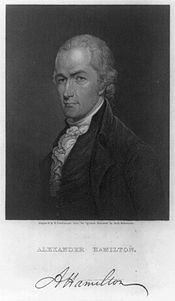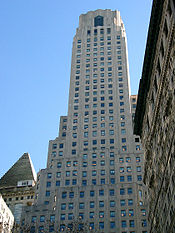- The Bank of New York Mellon
-
Bank of New York Mellon Corporation 
Type Public Traded as NYSE: BK Industry Banking Founded June 9, 1784 Headquarters 1 Wall Street
New York City, New York, U.SKey people Gerald Hassell
(Chairman, CEO and President)Products Financial Services Revenue  US$ 13.875 billion (2010)
US$ 13.875 billion (2010)Operating income  US$ 3.694 billion (2010)
US$ 3.694 billion (2010)Net income  US$ 2.518 billion (2010)
US$ 2.518 billion (2010)AUM  US$ 1.172 trillion (2010)
US$ 1.172 trillion (2010)Total assets  US$ 237.840 billion (2010)
US$ 237.840 billion (2010)Total equity  US$ 31.100 billion (2010)
US$ 31.100 billion (2010)Employees 48,000 (2010) Website BNYMellon.com The Bank of New York Mellon Corporation (NYSE: BK) is a global financial services company formed on July 1, 2007 as result of the merger of The Bank of New York and Mellon Financial Corporation.[1] The company employs more than 48,000 staff worldwide and has over US$ 1.2 trillion in assets under management and $25.5 trillion in assets under custody and administration thereby being the largest deposit bank in the world.[2] It operates in six primary financial services sectors including asset management, asset servicing, wealth management, broker-dealer and advisory services, issuance services, and treasury services.[3] It is the oldest banking corporation in the United States, tracing its origins to the establishment of the Bank of New York in 1784 by Alexander Hamilton.
Contents
History
Bank of New York
 The Walton Mansion housed the Bank of New York from 1784 to 1787.
The Walton Mansion housed the Bank of New York from 1784 to 1787.
 Alexander Hamilton shortly after the American Revolution.
Alexander Hamilton shortly after the American Revolution.
The Bank of New York was founded by Alexander Hamilton on June 9, 1784, in the old Walton Mansion in New York City.[4][5][6] The President of the new bank was former Major General Alexander McDougall, with William Winston Seaton as the Chief Cashier.[6] In 1792 when the New York Stock Exchange was first opened, The Bank of New York was the first company to be traded on the Exchange.[7] When the bank had been founded in 1784, it had been established by a series of documents drawn up by Alexander Hamilton.[6] It wasn't until May 2, 1791 that the Bank was able to procure a charter.[6]
The charter was renewed several times up until the era of free banking, when in 1852, it was officially recognized under Banking Law as a bank having a capital of $2,000,000.[6] Following the instigation of the National Banking Act, the Bank of New York in 1865 was once again chartered, this time as a National Bank via the act.[6]
Up through the early 1900s, the Bank of New York continued to expand and prosper.[5] In July 1922, the Bank of New York and the New York Life Insurance and Trust Company merged.[8] Because of the wise policies adopted by the management of the Bank, the firm managed to come through the Great Depression strengthened financially.[5] In 1948 the Bank once again merged, this time with the Fifth Avenue Bank, to be followed by a merger in 1966 with the Empire Trust Company.[5] That same year, 1966, the Bank of New York opened offices in London.[5] The addition of the London office, was instrumental in the establishment of the Bank on the international level.[5] The bank's holding company was created in 1969.[5] It was instrumental in the growth and expansion of the Bank of New York, outside of New York City.[5]
Mellon Financial
"T. Mellon & Son's Bank", as Mellon Financial was originally called, was founded in Pittsburgh, Pennsylvania.[9] The bank was established in 1869 by the retired Judge Thomas Mellon and his sons Andrew W. Mellon and Richard B. Mellon.[9] Alcoa, Westinghouse, and Bethlehem Steel amongst other industrial firms, were a few of the companies T. Mellon & Son's financed.[10] The former oil company Gulf Oil was considered to be one T. Mellon & Son's most successful financial investments.[11] The former Judge Thomas Mellon decided to retire from the firm as President in 1886 to be succeeded by his son, Andrew.[12]
In 1902, T. Mellon & Son's name was changed to that of the Mellon National Bank.[10] The firm merged with the Union Trust Company in 1946, a business founded by Andrew Mellon.[13] The name of the newly formed organization was the Mellon National Bank and Trust Company, Pittsburgh's first $1 billion bank.[13]
In 1920 Andrew left his leadership post of the bank to become the longest serving U.S. Treasury Secretary in history (serving under three separate administrations). In 1929, Richard founded Mellbank Corporation. In 1946, Mellon National, Mellbank, and the Union Trust Company merged to form Mellon National Bank and Trust Company. A reorganization in 1972 brought about a name change to Mellon Bank, N.A. and the formation of a holding company, Mellon National Corporation.
In 1983, Mellon bought Girard Bank of Philadelphia and Central Counties Bank of State College, Pennsylvania. The next year, Mellon National Corporation became Mellon Bank Corporation, and purchased Northwest Pennsylvania Corporation of Oil City, Pennsylvania. In 1986, Mellon bought Commonwealth National Financial of Harrisburg, Pennsylvania. In 1991, Mellon bought United Penn Bank of Wilkes-Barre, Pennsylvania. The next year, Mellon bought 54 branch offices of Philadelphia-based Philadelphia Savings Fund Society, whose parent company had become insolvent. Philadelphia Savings Fund Socity, was the first savings bank in the United States, founded in 1819.
In 1993, Mellon bought The Boston Company from American Express and AFCO Credit Corporation from The Continental Corporation. The next year, Mellon merged with the Dreyfus Corporation, bringing its mutual funds under its umbrella. 1998 saw Mellon's purchase of United Bankshares, Inc., of Miami, 1st Business Bank of Los Angeles, and Founders Asset Management.
In 1999, Martin G. McGuinn became chairman and chief executive officer of Mellon Bank Corporation. Mellon Bank Corporation then became Mellon Financial Corporation. In 2004, Mellon announced it would purchase Safeco Trust Company from Seattle-based Safeco Corporation. The same year, it purchased outstanding shares in London-based Pareto Partners and offered them floor space in Mellon Financial (opened earlier in the year).
Merger
 The Bank of New York Mellon headquarters at 1 Wall Street.
The Bank of New York Mellon headquarters at 1 Wall Street.
On December 4, 2006, Bank of New York and Mellon Financial Corporation announced that they would merge, creating the world's largest securities servicing and asset management firm. Under terms of the deal, Bank of New York's shareholders received 0.9434 shares in the new company for each share of Bank of New York that they owned, and Mellon shareholders (Taks) received 1 share in the new company for each Mellon share they owned. Bank of New York and Mellon entered into mutual stock option agreements for 19.9% of the issuer's outstanding common stock.
The new company, called Bank of New York Mellon Corporation, is the world's leading asset servicer by a considerable margin, with over $20 trillion in assets under custody (vaulting it over State Street Corporation, which has $15.1 trillion of assets under custody), and corporate trustee with $8 trillion in assets under trusteeship. It ranks among the top 10 global asset managers with more than $1 trillion in assets under management.
Coincidentally, the merger also brought together two financial institutions that had recently sold off their retail banking divisions. Bank of New York sold off their retail banking division to JPMorgan Chase in 2006, while Mellon sold their retail banking division to RBS-owned Citizens Financial Group in 2001.
It ranks as a top-10 U.S. wealth manager with more than $160 billion in client assets, and is a leading U.S. cash management and global payments provider. The company has annual revenues of about $13 billion, and pro-forma market capitalization of about $50 billion. The company has 40 thousand employees around the world. The Bank of New York Mellon Corporation operates in 37 countries, serving more than 100 markets. The company provides financial services for institutions, corporations, and high-net-worth individuals, through a worldwide team. It also services more than $11 trillion in outstanding debt.
Tom Renyi, former chairman and chief executive of Bank of New York, served as executive chairman of Bank of New York Mellon for 18 months following the close of the deal, with overall responsibility for the integration of the two companies, having retired effective July 1, 2008.
Robert P. Kelly, former president, chairman, and chief executive of Mellon, served as chief executive of the new company and succeeded Renyi as chairman of the board. Gerald L. Hassell, former president of Bank of New York, holds the same position in the new company.On August 31st 2011 Kelly resigned "by mutual agreement with the board of directors,due to differences in approach to managing the company" (quoting the press release issued) and his titles were added to Hassell's.
The board of directors had 10 members designated by Bank of New York, and 8 members designated by Mellon. The new company's headquarters is based in New York City, though they maintain significant operations in Pittsburgh.Kelly's resignation left 13 directors (8 from Bank of New York and 5 from Mellon).
The merger was finalized on July 2, 2007. The principal office of business was set at the One Wall Street office.The BNY Mellon brand name is used for most lines of business.
Post-merger
In February 2008, the company experienced a data spill, losing an undisclosed number of tapes containing customer information.[14] Victims of the data spill were offered two years of credit monitoring.
In late November 2008, the company announced that due to the global financial crisis, the company would be laying off 1,800 employees, translating into 4% of its global work force, with CEO Robert Kelly citing the need to "reduce expenses" past any post-merger plans.[15]
Financial crisis and anniversary
In October 2008, The Bank of New York Mellon received $3 billion in Troubled Asset Relief Program (TARP) funds from the U.S. Treasury during the financial crisis of 2007–2010. On June 9, 2009, the company paid back the funds in full, along with $136 million to buy back warrants from the Treasury.[16] The bank is the master custodian for the TARP funds, hired by the Treasury to handle accounting and record-keeping for the program.[17]
The bank also celebrated its 225th anniversary on June 9, 2009. The company honored this milestone with a commemorative video[18] addressing its history and prominent position in the global economy.
Historical data
The Bank of New York Mellon was the seventh largest bank at the end of 2008 (not including subsidiaries).[citation needed]
Locations
The Bank of New York Mellon operates in more than 100 markets in 36 countries worldwide, the group headquarters located at One Wall Street, European headquarters located in London and Asian headquarters located in Hong Kong.[20][21][22]
Business segments
- Asset Management (provides asset management services through a number of asset management companies to institutional and individual investors)
- Wealth Management (provides investment management, wealth and estate planning and private banking solutions to high net worth individuals and families, family offices and business enterprises, charitable gift programs and endowments and foundations)
- Asset Servicing (provides global custody and related services and broker-dealer services to corporate and public retirement funds, foundations and endowments and global financial institutions)
- Issuer Services (provides corporate trust, depositary receipt and shareowner services to corporations and institutions)
- Clearing Services (provides clearing, financing and custody services for broker-dealers and registered investment advisors)
- Treasury Services (provides treasury services, global payment services, working capital solutions, capital markets business and large corporate banking)[23]
See also
- Bank of New York
- Mellon Financial Corporation
- One Wall Street, Manhattan
- BNY Mellon Center (disambiguation)
- Pershing LLC
- CIBC Mellon
Notes
- ^ "BNY Mellon Profile". Google Finance. http://finance.google.com/finance?q=NYSE:BK. Retrieved 2007-08-06.
- ^ "BNY Mellon at a glance". The Bank of New York Mellon. http://www.bnymellon.com/about/ataglance.html. Retrieved 2009-03-30.
- ^ "Bank of New York Mellon Profile". Yahoo! Finance. http://finance.yahoo.com/q/pr?s=BK. Retrieved 2008-08-19.
- ^ Teather, David (2006-12-05). "Bank of New York merges with Mellon in £8bn deal". London: The Guardian. http://business.guardian.co.uk/story/0,,1963954,00.html. Retrieved 2007-08-08.
- ^ a b c d e f g h "Bank of New York Building Profile". NYC Architecture. http://www.nyc-architecture.com/LM/LM051-BANKOFNEWYORK.htm. Retrieved 2007-08-08.
- ^ a b c d e f "The History of New York States". USGenNet. http://www.usgennet.org/usa/ny/state/his/bk12/ch19/pt1.html. Retrieved 2007-08-08.[dead link]
- ^ "Bank of New York Profile". The New York Job Source. http://nyjobsource.com/bankofny.html. Retrieved 2007-08-08.
- ^ "New York's Oldest". TIME. 1934-03-26. http://www.time.com/time/magazine/article/0,9171,747266-1,00.html. Retrieved 2007-08-11.
- ^ a b "Mellon Financial Profile". The New York Job Source. http://nyjobsource.com/mellon.html. Retrieved 2007-08-09.
- ^ a b "Mellon Financial Corporation Profile". Excite Careers. http://www1.excite.com/home/careers/company_profile/0,15623,387,00.html. Retrieved 2007-08-16.
- ^ "Pittsburgh pride". Vault. http://www.vault.com/companies/company_main.jsp?product_id=939&ch_id=271&co_page=2&v=1. Retrieved 2007-09-06.
- ^ "Next Mellon". TIME. 1934-02-19. http://www.time.com/time/magazine/article/0,9171,747002,00.html. Retrieved 2008-08-23.
- ^ a b "The Mellons Go to Work Again". TIME. 1946-07-22. http://www.time.com/time/magazine/article/0,9171,888273,00.html. Retrieved 2008-09-08.
- ^ "Tape Query". http://www.bnymellon.com/tapequery/. Retrieved 2008-10-11.
- ^ "WaMu, BNY Mellon latest to shed jobs". http://www.msnbc.msn.com/id/27840008/. Retrieved 2008-11-12.
- ^ "Companies That Have Refunded Bailout Money". Propublica. http://bailout.propublica.org/main/list/refunds. Retrieved 22 November 2009.
- ^ Dash, Eric (2008-10-15). "Bank of New York Mellon Will Oversee Bailout Fund". The New York Times. http://www.nytimes.com/2008/10/15/business/economy/15tarp.html?_r=1&dbk. Retrieved 2010-05-25.
- ^ "Commemorative Video on YouTube". http://www.youtube.com/bnym225years. Retrieved 2009-06-08.
- ^ Money Economics Top 10 Banks Project
- ^ http://www.bnymellon.com/about/companyprofile.html
- ^ http://www.bnymellon.com/emea/uk/en/index.html
- ^ http://www.bnymellon.com/asiapacific/hongkong/en/index.html
- ^ http://www.bnymellon.com/pressreleases/2009/pdf/1q09earnings.pdf
External links
- Official website: Bank of New York Mellon
- Official career website: Bank of New York Mellon
- Google Finance: Bank of New York Profile
- YouTube: 225th Anniversary Commemorative Video
- iNautix: iNautix Technologies, a subsidiary of The Bank of New York Mellon
50 largest banks / bank holding companies in the United States as of September 30, 2011 - Ally
- American Express
- Associated
- BancWest*
- Bank of America
- Bank of New York Mellon
- BB&T
- BBVA Compass*
- BOK Financial
- Capital One
- CIT
- Citigroup
- Citizens Financial Group*
- City National (California)
- Comerica
- Commerce
- Discover
- East West Bank
- Fifth Third
- First Citizens
- First Horizon
- First Niagara
- Goldman Sachs
- BMO Harris*
- Hancock
- HSBC Bank USA*
- Huntington
- JPMorgan Chase
- Key
- M&T
- MetLife
- Morgan Stanley
- New York Community
- Northern Trust
- PNC
- Popular
- RBC*
- Regions
- Silicon Valley
- State Street
- SunTrust
- Synovus
- Taunus*
- TCF
- TD*
- U.S. Bank
- UnionBanCal*
- Utrecht-America*
- Wells Fargo
- Zions
* indicates the U.S. subsidiary of a non-U.S. bank. Inclusion on this list is based on U.S. assets only.Categories:- Companies listed on the New York Stock Exchange
- Banks based in New York City
- Companies established in 2007
- Mellon family
Wikimedia Foundation. 2010.



